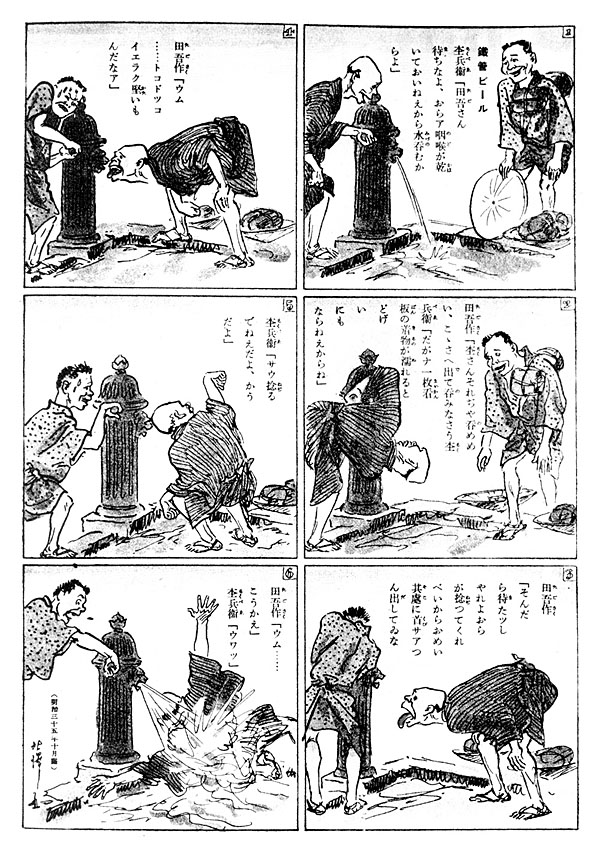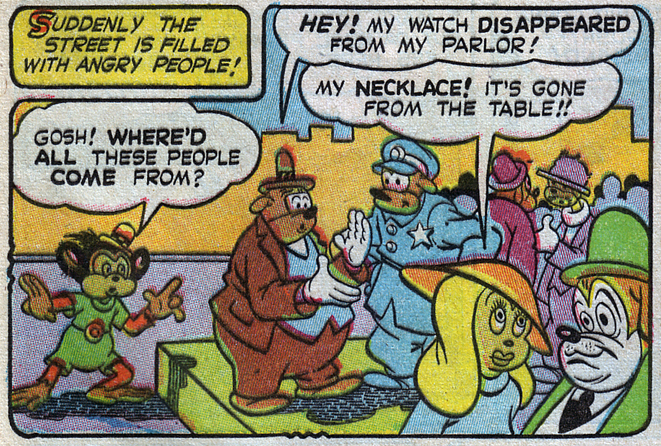|
Tymek I Mistrz
''Tymek i Mistrz'' (''Tymek and the Master'', ''Tim and the Master'') is a Polish children's humorous fantasy comic series authored by writer and illustrator . The series is about the adventures of sorcerer's apprentice Tymek and his teacher. It is set in the Middle Ages, but with numerous indications to the present times. During 2002-2004 the episodes of the comics were published in ', the children's comic newspaper supplement to ''Gazeta Wyborcza''. In 2003-2005 the episodes were collected into 40-page albums and published by Egmont Polska. In 2016-2017 the imprint " Krótkie Gatki" of the Polish comic book publisher published the complete set of ''Tymek i Mistrz'' in three volumes, including unpublished episodes, which were created after the cancellation of ''Komiksowo''. ''Tymek i Mistrz'' achieved a cult status in Poland, and its pieces can be found even in school textbooks of Polish language. It was also published by the Belgian comics magazine '' Spirou''. In 2014 Pol ... [...More Info...] [...Related Items...] OR: [Wikipedia] [Google] [Baidu] |
Fantasy Comedy
Fantasy comedy or comic fantasy is a subgenre of fantasy that is primarily humorous in intent and tone. Typically set in imaginary worlds, fantasy comedy often involves puns on, and parodies of, other works of fantasy. Literature The subgenre rose in the nineteenth century. Elements of fantasy comedy can be found in such nineteenth century works as some of Hans Christian Andersen's fairy tales, Charles Dickens' "Christmas Books", and Lewis Carroll's Alice (Alice's Adventures in Wonderland), Alice books."Humorous Fantasy" in David Pringle,ed, ''The Ultimate Encyclopedia of Fantasy'', (pp.31-33). London, Carlton,2006. The first writer to specialize in the subgenre was "Thomas Anstey Guthrie, F. Anstey" in novels such as ''Vice Versa (novel), Vice Versa'' (1882), where magic disrupts Victorian society with humorous results. Anstey's work was popular enough to inspire several imitations, including E. Nesbit's light-hearted children's fantasies, ''The Phoenix and the Carpet'' (1904) a ... [...More Info...] [...Related Items...] OR: [Wikipedia] [Google] [Baidu] |
Comics About Time Travel
a medium used to express ideas with images, often combined with text or other visual information. It typically the form of a sequence of panels of images. Textual devices such as speech balloons, captions, and onomatopoeia can indicate dialogue, narration, sound effects, or other information. There is no consensus among theorists and historians on a definition of comics; some emphasize the combination of images and text, some sequentiality or other image relations, and others historical aspects such as mass reproduction or the use of recurring characters. Cartooning and other forms of illustration are the most common means of image-making in comics. Photo comics is a form that uses photographic images. Common forms include comic strips, editorial and gag cartoons, and comic books. Since the late 20th century, bound volumes such as graphic novels, and comic albums, have become increasingly common, along with webcomics as well as scientific/medical comics. The history of ... [...More Info...] [...Related Items...] OR: [Wikipedia] [Google] [Baidu] |
Comics Adapted Into Television Series
a medium used to express ideas with images, often combined with text or other visual information. It typically the form of a sequence of panels of images. Textual devices such as speech balloons, captions, and onomatopoeia can indicate dialogue, narration, sound effects, or other information. There is no consensus among theorists and historians on a definition of comics; some emphasize the combination of images and text, some sequentiality or other image relations, and others historical aspects such as mass reproduction or the use of recurring characters. Cartooning and other forms of illustration are the most common means of image-making in comics. Photo comics is a form that uses photographic images. Common forms include comic strips, editorial and gag cartoons, and comic books. Since the late 20th century, bound volumes such as graphic novels, and comic albums, have become increasingly common, along with webcomics as well as scientific/medical comics. The history ... [...More Info...] [...Related Items...] OR: [Wikipedia] [Google] [Baidu] |
Comics Adapted Into Animated Series
a medium used to express ideas with images, often combined with text or other visual information. It typically the form of a sequence of panels of images. Textual devices such as speech balloons, captions, and onomatopoeia can indicate dialogue, narration, sound effects, or other information. There is no consensus among theorists and historians on a definition of comics; some emphasize the combination of images and text, some sequentiality or other image relations, and others historical aspects such as mass reproduction or the use of recurring characters. Cartooning and other forms of illustration are the most common means of image-making in comics. Photo comics is a form that uses photographic images. Common forms include comic strips, editorial and gag cartoons, and comic books. Since the late 20th century, bound volumes such as graphic novels, and comic albums, have become increasingly common, along with webcomics as well as scientific/medical comics. The history of ... [...More Info...] [...Related Items...] OR: [Wikipedia] [Google] [Baidu] |
2004 Comics Endings
4 (four) is a number, numeral and digit. It is the natural number following 3 and preceding 5. It is a square number, the smallest semiprime and composite number, and is considered unlucky in many East Asian cultures. Evolution of the Hindu-Arabic digit Brahmic numerals represented 1, 2, and 3 with as many lines. 4 was simplified by joining its four lines into a cross that looks like the modern plus sign. The Shunga would add a horizontal line on top of the digit, and the Kshatrapa and Pallava evolved the digit to a point where the speed of writing was a secondary concern. The Arabs' 4 still had the early concept of the cross, but for the sake of efficiency, was made in one stroke by connecting the "western" end to the "northern" end; the "eastern" end was finished off with a curve. The Europeans dropped the finishing curve and gradually made the digit less cursive, ending up with a digit very close to the original Brahmin cross. While the shape of the character for ... [...More Info...] [...Related Items...] OR: [Wikipedia] [Google] [Baidu] |
Comics About Magic
a medium used to express ideas with images, often combined with text or other visual information. It typically the form of a sequence of panels of images. Textual devices such as speech balloons, captions, and onomatopoeia can indicate dialogue, narration, sound effects, or other information. There is no consensus among theorists and historians on a definition of comics; some emphasize the combination of images and text, some sequentiality or other image relations, and others historical aspects such as mass reproduction or the use of recurring characters. Cartooning and other forms of illustration are the most common means of image-making in comics. Photo comics is a form that uses photographic images. Common forms include comic strips, editorial and gag cartoons, and comic books. Since the late 20th century, bound volumes such as graphic novels, and comic albums, have become increasingly common, along with webcomics as well as scientific/medical comics. The history of ... [...More Info...] [...Related Items...] OR: [Wikipedia] [Google] [Baidu] |
Fiction About Wizards
Fiction is any creative work, chiefly any narrative work, portraying individuals, events, or places that are imaginary or in ways that are imaginary. Fictional portrayals are thus inconsistent with fact, history, or plausibility. In a traditional narrow sense, fiction refers to written narratives in prose often specifically novels, novellas, and short stories. More broadly, however, fiction encompasses imaginary narratives expressed in any medium, including not just writings but also live theatrical performances, films, television programs, radio dramas, comics, role-playing games, and video games. Definition and theory Typically, the fictionality of a work is publicly expressed, so the audience expects a work of fiction to deviate to a greater or lesser degree from the real world, rather than presenting for instance only factually accurate portrayals or characters who are actual people. Because fiction is generally understood as not adhering to the real world, the theme ... [...More Info...] [...Related Items...] OR: [Wikipedia] [Google] [Baidu] |
Comic Series
a medium used to express ideas with images, often combined with text or other visual information. It typically the form of a sequence of panels of images. Textual devices such as speech balloons, captions, and onomatopoeia can indicate dialogue, narration, sound effects, or other information. There is no consensus among theorists and historians on a definition of comics; some emphasize the combination of images and text, some sequentiality or other image relations, and others historical aspects such as mass reproduction or the use of recurring characters. Cartooning and other forms of illustration are the most common means of image-making in comics. Photo comics is a form that uses photographic images. Common forms include comic strips, editorial and gag cartoons, and comic books. Since the late 20th century, bound volumes such as graphic novels, and comic albums, have become increasingly common, along with webcomics as well as scientific/medical comics. The h ... [...More Info...] [...Related Items...] OR: [Wikipedia] [Google] [Baidu] |
Comics Set In The Middle Ages
a medium used to express ideas with images, often combined with text or other visual information. It typically the form of a sequence of panels of images. Textual devices such as speech balloons, captions, and onomatopoeia can indicate dialogue, narration, sound effects, or other information. There is no consensus among theorists and historians on a definition of comics; some emphasize the combination of images and text, some sequentiality or other image relations, and others historical aspects such as mass reproduction or the use of recurring characters. Cartooning and other forms of illustration are the most common means of image-making in comics. Photo comics is a form that uses photographic images. Common forms include comic strips, editorial and gag cartoons, and comic books. Since the late 20th century, bound volumes such as graphic novels, and comic albums, have become increasingly common, along with webcomics as well as scientific/medical comics. The history of ... [...More Info...] [...Related Items...] OR: [Wikipedia] [Google] [Baidu] |
Polish Comics Titles
Polish may refer to: * Anything from or related to Poland, a country in Europe * Polish language * Polish people, people from Poland or of Polish descent * Polish chicken * Polish brothers (Mark Polish and Michael Polish, born 1970), American twin screenwriters * Kevin Polish, an American Paralympian archer Polish may refer to: * Polishing, the process of creating a smooth and shiny surface by rubbing or chemical action ** French polishing, polishing wood to a high gloss finish * Nail polish * Shoe polish * Polish (screenwriting), improving a script in smaller ways than in a rewrite See also * * * Polishchuk (surname) * Polonaise (other) {{Disambiguation, surname Language and nationality disambiguation pages ... [...More Info...] [...Related Items...] OR: [Wikipedia] [Google] [Baidu] |







